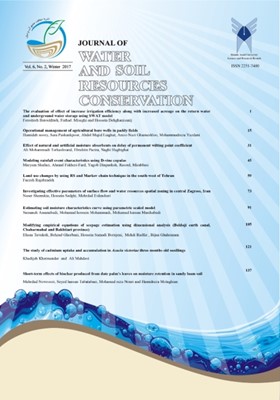Operational management of agricultural bore wells in paddy fields
Subject Areas : Farm water management with the aim of improving irrigation management indicatorsHamideh noory 1 * , sara Pashankpoor 2 , Abdol Majid Liaghat 3 , Arezo Nazi Ghameshloo 4 , Mohammadreza Yazdani 5
1 - استادیار؛ گروه مهندسی آب؛ پردیس کشاورزی و منابع طبیعی دانشگاه تهران؛ البرز؛ ایران
2 - دانشآموخته کارشناسی ارشد آبیاری و زهکشی؛ پردیس کشاورزی و منابع طبیعی دانشگاه تهران؛ البرز؛ ایران
3 - استاد؛ گروه مهندسی آب؛ پردیس کشاورزی و منابع طبیعی دانشگاه تهران؛ البرز؛ ایران
4 - استادیار؛ گروه مهندسی آب؛ پردیس کشاورزی و منابع طبیعی دانشگاه تهران؛ البرز؛ ایران
5 - استادیار پژوهشی؛ مؤسسه تحقیقات برنج کشور؛ سازمان تحقیقات، آموزش و ترویج کشاورزی؛ گیلان؛ ایران
Keywords: shallow groundwater, hydrus-1D, irrigation, Simulation model,
Abstract :
In this research, an operational simulation model was developed to indicate the importance of agricultural bore wells as an irrigation water resource and sustainable management of them to supply irrigation demand of paddy fields. The main approach of this research was based on maximum using of local water resources (e.g. wells, ponds). In the proposed model, crop evapotranspiration, irrigation requirement and interval and water head in soil and bore well are daily calculated based on input data and simulation equations. Then, using of obtained irrigation scheduling and considering the limitation of minimum permission level in bore well, water harvesting days from bore well, pumping discharge and time, pond water in fields and runoff are calculated. Simulation of groundwater level fluctuation in the out of paddy rice growing season in unsaturated condition of soil was computed by Hydrus-1D. The model was run for paddy fields of Rasht Rice Research Institute for normal year; The results indicated that 10 irrigation events were required that six and four of them were supplied by bore well and canal, respectively. The obtained results in the studied paddy fields showed that shallow groundwater level was discharged by precipitation in the out of paddy rice growing season and raised from depth of 4.85 m to 1.82 m. Therefore, operation of bore wells during paddy rice growing season as well as considering minimum permission water head does not cause considerable groundwater drawdown and unsustainable operation
آزرمسا، م. فیاض، م. تطهیری، م. 1379. مدیریت منابع و مصرف آب شبکه آبیاری و زهکشی سفیدرود. دهمین همایش کمیته ملی آبیاری و زهکشی ایران. تهران، خرداد ماه 1379.
پشنکپور، س. 1394. مدیریت بهرهبرداری از چاههای کشاورزی در اراضی شالیزاری شبکه سفیدرود. پایان نامه کارشناسی ارشد آبیاری و زهکشی، پردیس کشاورزی، دانشگاه تهران، گروه آبیاری و آبادانی. 153 صفحه.
رضویپور کومله، ت. ۱۳۷۸. اندازهگیری نفوذ عمقی آب در بافتهای مختلف خاک شالیزار در دو مرحله از رشد برنج. پایان نامه کارشناسی ارشد خاکشناسی، دانشکده کشاورزی، دانشگاه آزاد اسلامی واحد علوم و تحقیقات. 110 صفحه.
علیزاده، ا. 1378. اصول هیدرولوژی کاربردی، انتشارات آستان قدس رضوی، شماره نشر 35، چاپ یازدهم، 622 صفحه، 331-403.
گزارش موسسه تحقیقات برنج رشت، 1393،www.berenj.areo.ir.
Allen, R.G., Pereira, L.S., Raes, D., Smith, M. 1998. Crop evapotranspiration–guidelines for computing crop water requirements. FAO Irrigation and Drainage Paper 56. FAO, Rome.333 pages.
Boldt, A.L., Eisenhauer, D. E., Martin, D.L. and Wilmes, G.J. 1999. Water Conservation practices for a River Valley Irrigated with Groundwater. Agricultural Water Manage. 30: 235–256.
Chenaf, D., and Chapuis, R. P. 2007. Seepage face height, water table position, and well efficiency at steady state. Groundwater, 45(2): 168-177.
Croke, B.F.W., F. Andrews, J. Spate and Cuddy, S.M. 2005. IHACRES user guide. Technical Report 2005/19. Second Edition. iCAM, School of Resources, Environment and Society, The Australian National University, Canberra.http://www.toolkit.net.au/ihacres.
Dewandel, B., Gandolfi, J.M., Condappa, D. and de Ahmed, S. 2008. An Efficient Methodology for Estimating Irrigation Return Flow Coefficients of Irrigated Crops at Watershed and Seasonal Scale. Hydrological Process. 22: 1700-1712.
Ito, Y., Shiraishi, H. and Oonishi, R. 2000. Numerical Estimation of Return Flow in River Basin. Japan Agricultural Research Quarterly, 14(1): pp.24-30.
Kim, H.K., Jang, T.I., Im, S.J. and Park, S.W. 2009. Estimation of Irrigation Returns Flow From Paddy Fields Considering The Soil Moisture. Agricultural Water Management, 96: 875-882.
Liu, C.W., Huang, H.C., Chen, S.K. and Kuo, Y.M. 2004. Subsurface return flow and ground water recharge of terrace fields in northern Taiwan. Journal of the American Water Resources Association 40: 603–614.
Nakagiri, T., Watnabe, T., Horino, H. and Maruyama, T. 2000. Analysis of Sufficiency andReuse of Irrigation Water in The Kino River Basin—Analysis of Irrigation Water UseBy a Basin Hydrological Model (ii). Transactions of the Japanese Society of Irrigation, Drainage and Reclamation Engineering 205: 35–42 (in Japanese, withEnglish abstract).
Simunek, j., Sejan, M. and Van Genuchten, M. Th. 1998. The HYDRUS-1D software package for simulating the one-dimensional movement of water , heat and multiple solutes in variably saturated media Research report No. 144, U. S. Salinity Lab., USDA, Riverside, California. 164 pages.
van Genuchten, M. 1980. A closed-form equation for predicting the hydraulic conductivity of unsaturated soils. Soil Science Society of America Journal. 44 (5): 892–898.

